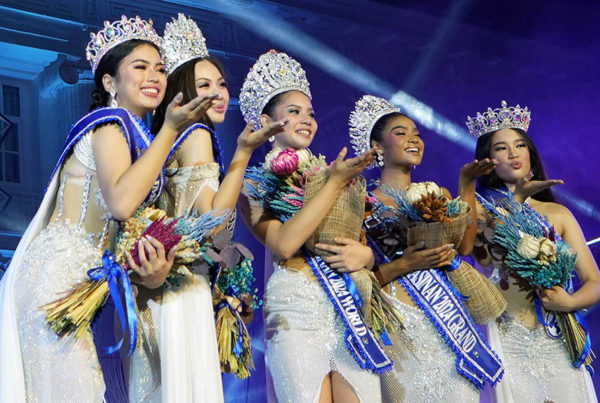“Pinablin Dalin” traces roots and culture of a people
HISTORY OF PANGASINAN
LINGAYEN—Finally, a history book on Pangasinan titled “Pinablin Dalin” was launched during the commemorative program of the 435th Agew na Pangasinan (Pangasinan founding anniversary) on April 10 at the Capitol Plaza here.
The book bares the historical journey and cultural roots of the province and its people.
Pinablin Dalin was prepared and edited by the Pangasinan Historical and Cultural Commission group of writers and researchers headed by Dr. Gonzalo Duque.
It was also based on the research study by a group headed by Dr. Perla Legaspi, a former Vice-Chancellor of UP Diliman.

RECORDING PANGASINAN CULTURE. Gov. Amado Espino Jr. signs a copy of the “Pinablin Dalin” for Pangasinan Historical and Cultural Commission chairman, Dr. Gonzalo Duque, during the 435th Agew na Pangasinan celebration on April 10, 2015. Pinablin Dalin is the Pangasinan history book launched on the same event.
The book is seen to be the main resource material for the integration of Pangasinan study in the education curriculum.
“Today, we just witnessed the formal launching and presentation of this important history book, to be used, among others, as the basic reference for mandatory classes in Pangasinan History in all elementary and high schools in Pangasinan,” said Governor Amado Espino Jr.
He also encouraged everyone to buy their own copies of this book.
Also launched during the event was the “Kurit Panlunggaring” anthology book 1 which contains the winning entries of the 2012-2014 Pangasinan literary awards.
Winners in the different categories-poetry, essay, short story, and children story writing- of this year’s Kurit Panlunggaring were also awarded with trophies and cash prizes.
Launched in 2011, Kurit Panlunggaring is the Pangasinan equivalent of the Palanca Literary Awards, “designed to encourage budding young writers to use Pangasinan as a medium of literary expression,” said the Governor.
Espino said Pangasinan is the first province in the entire country to have its own local language orthography or the formal system of spelling and correct usage of words in particular language.
The Pangasinan Orthography was officially adopted by the Komisyon ng Wikang Filipino (KWF) in April 2012.
Meanwhile, Mr. Espino urged the Pangasinan natives to develop deeper love for their province’s heritage.
“It is most important for us to realize, that in this present global village, where modern technology has defied the barriers of time and space, each of us needs to know, and to develop a deeper sense of, our uniqueness as a people, and to feel secure and confident in that distinct cultural identity,” he said.
“Otherwise, we will suffer the sad fate of becoming just like the other nameless faces in the crowd of nations,” he added.
He told them that before one can become a good and patriotic Filipino, he or she has to become a good and patriotic Pangasinan.
Mr. Espino also pushed for a renewed commitment “to continue the work with our individual best effort, in pursuing our collective vision of Pangasinan as the best place to invest, work, live, and raise a family.”
Meanwhile, 52 floats representing various local government units, government agencies, provincial government and its hospitals, and private organizations have joined this year’s float parade dubbed “Parada na Dayew”
Among the LGUs that joined were Bolinao, Infanta, Burgos, Balungao, Anda, Agno, Asingan, Laoac, Bautista, San Jacinto, Urbiztondo, Alaminos City, Basista, and San Carlos City.
In the evening, the province presented the ASNA awards to the Pangasinenses who have distinguished themselves in their respective fields.
This year’s ASNA awardees are Agerico Orbos (Spiritual Leadership), Ana Marie Pamintuan (Journalism), Cecilia Daranciang (Culture and Arts), Francisco Viray (Corporate Leadership), Perla Legaspi (Public Administration), Emilio Sanglay Jr. (Music), Rebecca Bustamante (Entrepreneurship), Victor Ramos (Environment), Vivencio Villaflor Jr. (Humanitarian and Civic Leadership), and Hermogenes Pobre (Special Award for Public Service).
Launched in 2010, ASNA Awards accords the highest expression of recognition to Pangasinan natives whose lives, works, and ideals exemplify selfless dedication to service to fellowmen and to country- truly a remarkable legacy to their provincemates and generations of Filipinos.
Asna is an old form of the Pangasinan word ‘asin,’ describing the good quality of a man’s character or demeanor.
| 2015 Agew na Pangasinan was the sixth consecutive year, since April 5, 2010, that such event was celebrated.This year, it was held on April 10 to give way to the celebration of Easter Sunday. (Johanne Macob) |
Share your Comments or Reactions
Powered by Facebook Comments









